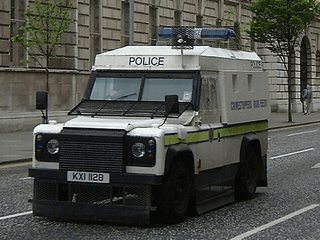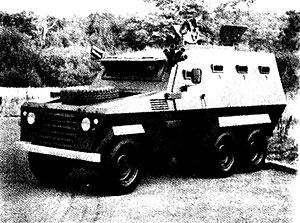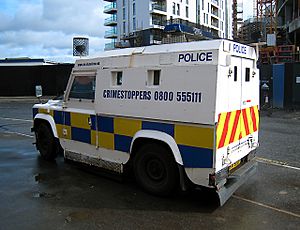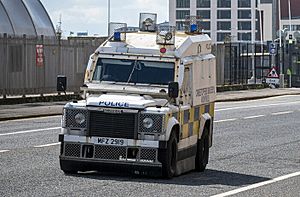Land Rover Tangi facts for kids
The Land Rover Tangi is a special armoured vehicle. It is built on a Land Rover frame. Police in Northern Ireland use it. The Royal Ulster Constabulary (RUC) first used them. Now, the Police Service of Northern Ireland (PSNI) uses them. Police engineers designed and built these vehicles themselves.
Contents
Armoured Land Rovers in Northern Ireland
Because of a time of conflict called the Troubles in Northern Ireland, the RUC needed armoured vehicles. These vehicles helped keep police officers safe. The first armoured Land Rover appeared in 1957. It was based on a Series 1 pick-up truck. It had basic protection against things like bricks and bottles during public disorder. Metal cages covered the back and windows to stop objects from breaking them.
However, police soon faced attacks with guns. The early cages did not protect against bullets. So, steel plates were added to the sides and back. This helped against some low-speed weapons. But many parts of the vehicle were still open. The RUC knew they needed a much better design.
The Hotspur Land Rover
The next design was called the Hotspur Land Rover. It was named after the strong armour used to build it. It used the frame of a regular Land Rover station wagon. A second roof made of armoured steel was put under the normal roof. This protected against gunfire, petrol bombs, and small IEDs (homemade bombs).
Large steel plates were bolted to the sides. These plates wrapped around the back. The back had armoured double doors. Both the doors and side plates had small sliding openings. Officers could fire through these if they were attacked. The back, sides, and roof formed a strong armoured box. This protected the officers inside.
For the driver and front passenger, the windows were replaced with thick bulletproof glass. The front doors were also armoured. A strong metal grille could be pulled over the windscreen. This stopped objects from breaking the glass during riots. The side windows had clear plastic covers for the same reason.
The Hotspur was used right away and worked very well. Over time, many changes were made. For example, plastic sheets were added to the lower sides. This stopped the vehicle from getting dents during riots. Metal grilles and rubber skirts were added around the bottom. This stopped objects from being thrown under the vehicle. It also prevented large items like beer kegs from rolling underneath to stop the vehicle.
By late 1983, 151 Hotspurs had a fire extinguishing system. If a petrol bomb hit the vehicle, a button was pressed. This turned off fans and sprayed fire extinguisher fluid. It covered the engine and front of the vehicle.
The Simba Land Rover
The Hotspur was later joined by a more advanced vehicle called the Simba. The Simba was not just a regular Land Rover with armour added. It was built with a special armoured steel body. This gave 360-degree protection. It could stop high-speed rifle fire, bricks, bottles, petrol bombs, and small homemade bombs.
However, the Simba was slow to build. The Hotspur Land Rovers were also getting old. So, a faster way to get more armoured police vehicles was needed. The answer was the Land Rover Tangi.
The Tangi Vehicle
Armour kits from old Hotspurs were put onto new Land Rover Defender 110 frames. When they ran out of old kits, the police workshops made new ones. At first, clear plastic shields protected the headlights. But these were not as strong as the Hotspur's metal grilles. So, the metal grilles were brought back.
Each Tangi had a remote-controlled spotlight and a blue flashing light on the roof. These were protected by metal grilles. The side skirts from the Hotspur were kept. The fire protection system was also kept. To stop burning petrol from getting into the engine, a fabric strip was added around the bonnet. The engine's radiator was also protected by a strong steel grille.
The first Tangi started work on January 16, 1986. Police officers liked the Tangi much more than the Hotspur. It had power steering, better suspension, and disc brakes. It also had air conditioning from the factory. Plus, it was very strong against most things thrown during riots.
Dawson Roof and Side Armour
During a riot in Belfast, a homemade bomb damaged the roof of a Tangi. The officers inside were safe because they had put riot shields above their heads. This led to the "Dawson roof" design. The new roofs had a second steel roof placed over the first. This worked like "spaced armour." It made the bomb explode before it hit the main armoured roof. Tangis with the Dawson roof looked big and angular.
Other homemade bombs were made to be thrown sideways. This was to get around the extra roof armour. The RUC added a similar protection to the sides. A steel plate was placed a few inches from the main body. This made the bomb explode before it hit the main armour. With the Dawson roof and strong side armour, the Tangi is still seen in Northern Ireland today.
How Tangis Are Used
Local people sometimes call Tangis "Meat Wagons." This name comes from other armoured vehicles used by the British Army in Northern Ireland. The vehicles are closely linked to The Troubles in Northern Ireland. During the worst times of the Troubles, these vehicles were vital for patrols. They carried two officers in the front. Up to five officers with riot helmets and shields could ride in the back. At that time, they were painted dark grey.
Since the Good Friday Agreement and the peace that followed, Tangis are mostly used for crowd control. Some are still used for patrols in areas where small groups still cause trouble. The vehicles are now painted white, yellow, and blue. These are the standard colours for most police vehicles in the United Kingdom. The old blue flashing lights have been replaced with modern light bars.
Current Status of Tangis
More than half of the RUC (now PSNI) fleet of 450 armoured Land Rovers were taken out of service. This was part of the Good Friday Agreement. Some Tangis were sent back to Great Britain. They were updated and given to other police forces in the UK. For example, North Wales Police and South Yorkshire Police use Tangis. After riots in Bradford in 2001, West Yorkshire Police bought six.
In Northern Ireland, Tangis are slowly being replaced. Newer models like the OVIK PANGOLIN and Penman Public Order Land Rover are taking their place.
The Tangi has also become popular with collectors. You can find toy models and artwork of these vehicles.
The Hotspur Hussar
The Hotspur Hussar is a military armoured vehicle. It was designed in 1984. It is based on the Land Rover Hotspur and Tangi. It has a third driven axle, making it a 6x6 vehicle. This means it has six wheels, all of which can be powered. It can carry two crew members and ten fully equipped soldiers. It can travel over rough ground. It can have up to six gun ports. Soldiers inside can fire at an enemy through these. The Hotspur Hussar was sold to countries like Egypt and Sri Lanka.
See also
- Snatch Land Rover – a similar vehicle used by the Army during The Troubles
- Shorland – another armoured car based on a Land Rover





